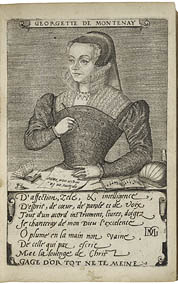At the Folger Shakespeare Library in Washington, D. C., I recently visited a fascinating exhibition entitled Shakespeare’s Sisters: Voice of English and European Women Writers, 1500-1700. The exhibition website is here.
The exhibition began with a famous passage from Virginia Woolf’s 1929 volume A Room of One’s Own: “(W)hat would have happened had Shakespeare had a wonderfully gifted sister, called Judith, let us say…it needs little skill in psychology to be sure that a highly gifted girl who had tried to use her gift for poetry would have been so thwarted and hindered…that she must have lost her health and sanity.”
In Woolf’s day, little was known about women who might have written — and even published — in Shakespeare’s day. But recent scholarship has brought to light a number of such writers and some of their work is shown in this exhibition.
Georgette de Montenay, Emblemes ou devises Chrestiennes, 1619
Folger Shakespeare Library Collection
Obviously, due to the age and fragility of the books shown, photographs of them were not allowed, and due to the low light level, my photographs of the text panels are sometimes rather dim. Sorry about that, but I thought you’d rather see them as is than not. Refer to the website for the texts.
The exhibition is divided into several sections covering such subjects as Religious Writing, Love and Romance, and Families and Salons. Below, a panel celebrating poetry. In the center is Veronica Franco (1546-1591), a Venetian poet and courtesan.
The portrait of Franco is said to be by Tintoretto. A biography, The Honest Courtesan, by Margaret F. Rosenthal, was the basis of a film about Franco’s life.
The film, titled in the U.S. Dangerous Beauty (1998) starred Catherine McCormick as Franco, Jacqueline Bisset and Rufus Sewell. I cannot vouch for the accuracy of the film’s story, but it does emphasize Franco’s writing talents as well as giving sumptuous views of 16th century Venice and its inhabitants.
To my knowledge, no one has filmed a life of Lady Anne Clifford, but her life would be good material for a creative screen writer and director.
A reproduction of a triptych (attributed to Jan van Belcamp) showing Lady Anne Clifford on either side; in the center panel is Margaret Russell, Countess of Cumberland, and George Clifford, 3rd Earl of Cumberland, with their two sons, is on display.
Here is a closer view of Lady Anne Clifford at age sixteen.
Lady Anne Clifford was raised in the Court of Elizabeth I; she married the Earl of Dorset and later of Pembroke. Not only is she well known for her letters and diaries, she was also a dedicated patron of the arts and literature. She fought for her legal rights to the family estates for almost forty years before she gained success. She was truly a Renaissance woman. Below, Lady Anne at age 56.
Vita Sackville-West (1892-1962) wrote about Lady Anne in her study of her family and its great estate, Knole and the Sackvilles, published in 1922, and in introducing her works.
Vita Sackville-West
Sackville-West, close friend and colleague of Virginia Woolf, also wrote a biography of another of the exhibition’s subjects, Aphra Behn (1640-1689). Best known as a playwright, Behn also wrote novels and poetry. Her plays were very popular in the Restoration era theatre in England.
Aphra Behn by Mary Beale
Gravestone of Aphra Behn, in the Cloister of Westminster Abbey, London
The inscription: Here lies a Proof that Wit can never be
Defense enough against Mortality
I recommend spending time on the exhibition’s website, Shakespeare’s Sisters, for many further insights into this fascinating topic: Voices of English and European Women Writers, 1500-1700.
Below, the Folger Shop.
I would be remiss if I did not give the website of the
Folger Shop which has wonderful books, catalogues, cards, and assorted items relating to the Woman Writers exhibition as well as to Shakespeare and his era. I highly recommend a visit to the Folger when you come to Washington, D.C. And what’s more: admission is free!
.jpg)








Thank you for posting this!
Gentle hugs,
"Auntie"